-
 Bitcoin
Bitcoin $83,692.3503
0.83% -
 Ethereum
Ethereum $1,817.6072
1.05% -
 Tether USDt
Tether USDt $0.9997
-0.01% -
 XRP
XRP $2.1571
4.64% -
 BNB
BNB $597.9442
0.92% -
 Solana
Solana $121.3486
4.34% -
 USDC
USDC $1.0000
0.01% -
 Dogecoin
Dogecoin $0.1701
3.73% -
 Cardano
Cardano $0.6627
2.07% -
 TRON
TRON $0.2366
-0.80% -
 Chainlink
Chainlink $12.9968
1.79% -
 UNUS SED LEO
UNUS SED LEO $8.9254
-4.67% -
 Toncoin
Toncoin $3.2910
-5.61% -
 Stellar
Stellar $0.2571
-0.87% -
 Avalanche
Avalanche $18.2770
1.18% -
 Sui
Sui $2.2536
2.53% -
 Shiba Inu
Shiba Inu $0.0...01238
1.05% -
 Hedera
Hedera $0.1630
0.81% -
 Litecoin
Litecoin $83.8930
0.33% -
 Polkadot
Polkadot $4.0032
-0.63% -
 MANTRA
MANTRA $6.2613
-0.60% -
 Bitcoin Cash
Bitcoin Cash $303.7265
-0.19% -
 Bitget Token
Bitget Token $4.5099
0.36% -
 Dai
Dai $1.0001
0.01% -
 Ethena USDe
Ethena USDe $0.9990
-0.06% -
 Pi
Pi $0.6727
25.93% -
 Hyperliquid
Hyperliquid $12.0801
5.29% -
 Monero
Monero $216.8337
0.33% -
 Uniswap
Uniswap $5.9215
0.58% -
 OKB
OKB $51.4710
9.89%
Which is more cost-effective, OTC trading of USDT or buying it directly from an exchange?
The choice between OTC and exchange purchases of USDT depends on factors like fees, speed, privacy, and transaction size, each affecting cost-effectiveness differently.
Mar 30, 2025 at 02:15 pm
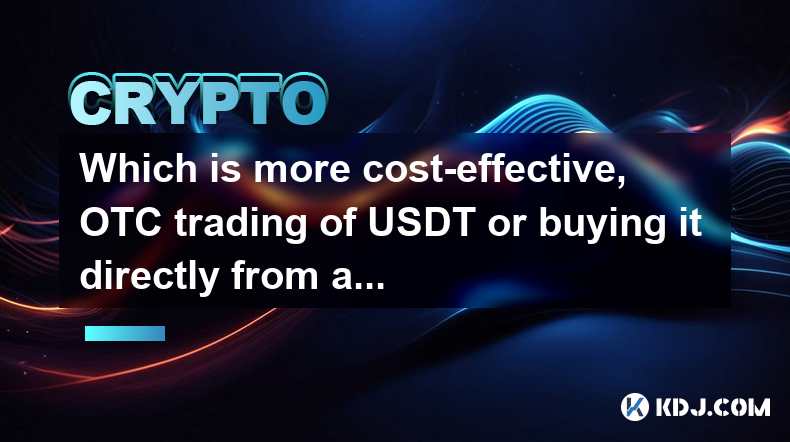
Understanding the Cost Dynamics of USDT Acquisition
The choice between over-the-counter (OTC) trading and direct exchange purchases for Tether (USDT) depends on several factors influencing overall cost-effectiveness. Both methods have their own sets of fees, transaction speeds, and limitations. Understanding these nuances is crucial for making an informed decision.
Directly buying USDT from a cryptocurrency exchange is generally a straightforward process. Most exchanges offer USDT pairs with various fiat currencies (like USD, EUR, etc.) or other cryptocurrencies. The cost here primarily involves trading fees, which vary significantly across platforms. These fees are usually a percentage of the transaction value. Additionally, some exchanges might have deposit or withdrawal fees for fiat currencies.
OTC trading, on the other hand, involves trading USDT directly with a counterparty, often a large institution or broker. This method usually bypasses public order books, providing a level of privacy and potentially larger transaction sizes. However, OTC trades often involve higher minimum transaction amounts and may have higher fees, especially for smaller trades. These fees are usually negotiated beforehand and can be structured differently than exchange fees.
Analyzing the Fees Involved in Each Method
Exchange fees are typically transparent and readily available on the exchange's website. They are usually charged as a maker/taker fee based on whether you are adding liquidity to the order book (maker) or taking liquidity from it (taker). The fees can range from 0.1% to 0.5% or even higher, depending on the exchange and your trading volume. Always check the specific fee schedule of your chosen exchange.
OTC trading fees are less transparent. They are usually negotiated between the buyer and seller and can include a percentage of the transaction value, a fixed fee, or a combination of both. Negotiating a favorable fee is crucial in OTC trading, particularly for large transactions. Hidden costs might also exist, such as intermediary fees or transfer charges.
Transaction Speed and Liquidity
Purchasing USDT directly from an exchange offers relatively fast transaction speeds. Once the order is placed and confirmed, the USDT is usually credited to your account within minutes, depending on the exchange's processing time and network congestion. Liquidity is generally high on major exchanges, enabling quick execution of trades, even for large orders.
OTC trading, while potentially offering higher transaction volumes, can be slower. The process involves finding a suitable counterparty, negotiating the terms, and completing the transaction, which can take anywhere from a few hours to several days. Liquidity might be less readily available compared to exchanges, especially for less common trading pairs. Time sensitivity is a crucial factor to consider.
Privacy and Security Considerations
Exchanges typically require KYC (Know Your Customer) and AML (Anti-Money Laundering) compliance, meaning you'll need to provide personal information. While this ensures security for the platform and its users, it compromises a degree of privacy. Your trading activity is recorded on the exchange's platform.
OTC trading often offers a higher degree of privacy. You may not be required to provide as much personal information to your counterparty, depending on the regulatory environment and the transaction size. However, choosing a reputable and trustworthy counterparty is essential to mitigate security risks in OTC trading. Thorough due diligence is required to ensure the counterparty is legitimate and reliable.
Minimum Transaction Amounts and Volume
Exchanges typically have no minimum transaction amounts, allowing users to buy even small quantities of USDT. This flexibility is beneficial for those with limited capital or those experimenting with cryptocurrency.
OTC trading usually involves higher minimum transaction amounts. This is because the process of negotiating and executing the trade is more resource-intensive for the counterparty. OTC is generally more suitable for high-volume transactions. For smaller amounts, the fees might outweigh the benefits.
Regulatory Compliance and Legal Aspects
Both exchange and OTC trading are subject to varying degrees of regulatory scrutiny. Exchanges are generally more heavily regulated, adhering to KYC/AML rules and other compliance requirements. The regulatory landscape for OTC trading can be more complex and varies significantly depending on jurisdiction. Understanding the legal implications of both methods in your region is crucial.
Choosing the Right Method: A Practical Approach
The most cost-effective method depends on your individual circumstances. For smaller transactions and a need for speed and transparency, direct exchange purchases are generally more efficient. For larger transactions, a higher degree of privacy, or the need to bypass public order books, OTC trading might be preferable, provided you can negotiate favorable fees and find a reliable counterparty.
Frequently Asked Questions
Q: Are there any hidden fees associated with OTC USDT trading?
A: Yes, there can be hidden fees in OTC trading, such as intermediary fees or transfer charges. These are not always transparent upfront and should be clarified during negotiations.
Q: Which method offers better privacy?
A: OTC trading generally offers better privacy than exchange trading, as it doesn't require the same level of KYC/AML compliance.
Q: Which method is faster?
A: Exchange trading is significantly faster, with transactions usually completed within minutes. OTC trading can take hours or even days.
Q: What are the minimum transaction amounts for each method?
A: Exchanges usually have no minimum, while OTC trading typically has significantly higher minimum transaction amounts.
Q: How do I find a reputable OTC counterparty?
A: Finding a reputable OTC counterparty requires thorough research and due diligence. Look for established brokers with positive reviews and a proven track record. Consider referrals from trusted sources within the cryptocurrency community.
Q: Are there any tax implications to consider?
A: Yes, both exchange and OTC trading of USDT have tax implications that vary depending on your location and the specific regulations in your jurisdiction. It's recommended to consult with a tax professional for guidance.
Disclaimer:info@kdj.com
The information provided is not trading advice. kdj.com does not assume any responsibility for any investments made based on the information provided in this article. Cryptocurrencies are highly volatile and it is highly recommended that you invest with caution after thorough research!
If you believe that the content used on this website infringes your copyright, please contact us immediately (info@kdj.com) and we will delete it promptly.
- title: Dogecoin (DOGE) Shows Resilience Despite Bitcoin (BTC) and Altcoin Market Downturn
- 2025-04-05 18:20:12
- Fartcoin (STPT) Down After Explosive Rally as Investors Take Profits
- 2025-04-05 18:20:12
- NodeOps Network Unveils Innovative Pre-Sale Price Discovery Mechanism
- 2025-04-05 18:15:12
- MIND of Pepe Presale Closes On $8 Million – Next Crypto To Explode?
- 2025-04-05 18:15:12
- The Next Bitcoin Treasury Company May Not Be a U.S. Tech Giant
- 2025-04-05 18:10:12
- Market Greed Turns to Bloodbath as Nearly $300M Worth of Perpetual Futures Positions Get Liquidated
- 2025-04-05 18:10:12
Related knowledge
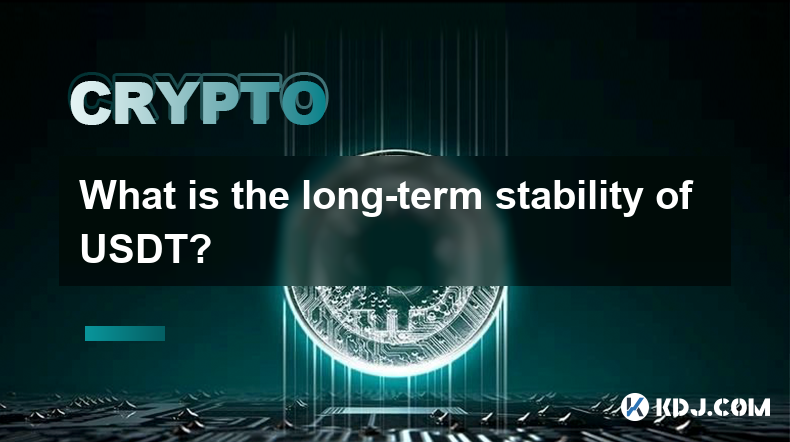
What is the long-term stability of USDT?
Apr 04,2025 at 10:28pm
The long-term stability of USDT, also known as Tether, is a topic of significant interest within the cryptocurrency community. USDT is a type of stablecoin, designed to maintain a stable value by being pegged to a reserve asset, typically the US dollar. The stability of USDT is crucial for its widespread use in trading, as a hedge against volatility, an...
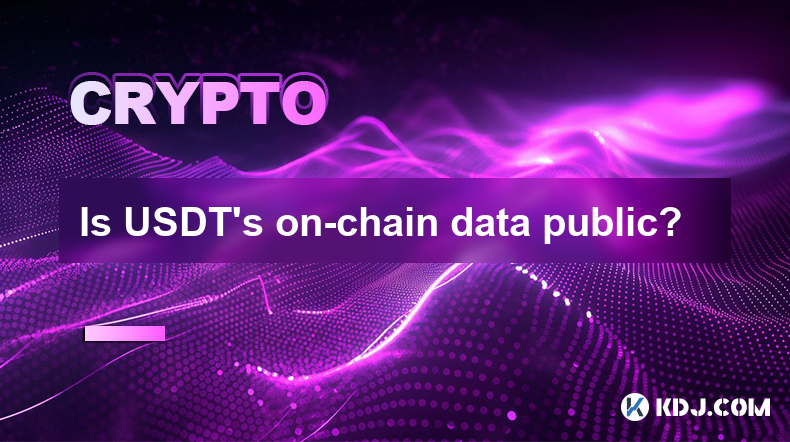
Is USDT's on-chain data public?
Apr 05,2025 at 08:49am
The transparency of USDT's on-chain data is a topic of significant interest within the cryptocurrency community. Tether, the company behind USDT, claims that its operations are transparent and that the on-chain data is publicly accessible. However, understanding the nuances of this data and how to access it can be challenging. This article will delve in...
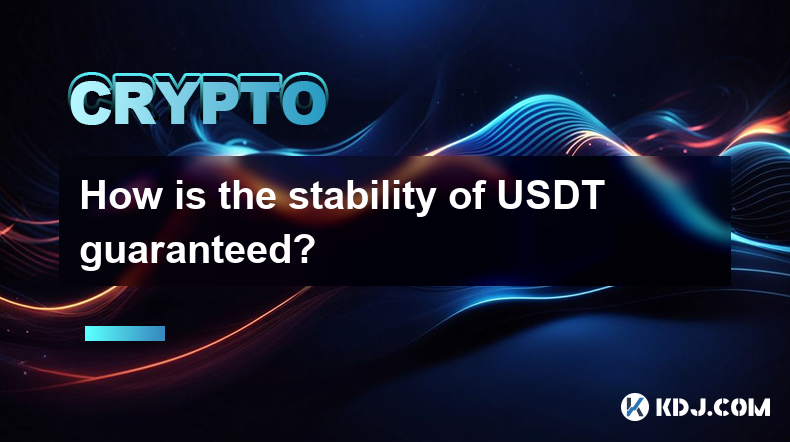
How is the stability of USDT guaranteed?
Apr 03,2025 at 06:00am
The stability of USDT, also known as Tether, is a critical aspect that underpins its role as a stablecoin in the cryptocurrency market. USDT is designed to maintain a 1:1 peg with the US dollar, which is achieved through a combination of mechanisms and practices. Understanding these elements is essential for anyone interested in the stability and reliab...

How is USDT compliant?
Apr 05,2025 at 11:28am
USDT, also known as Tether, is a stablecoin that aims to maintain a stable value by being pegged to the US dollar. Ensuring compliance is crucial for Tether to maintain its reputation and operational integrity within the cryptocurrency ecosystem. Compliance in the context of USDT involves adhering to various regulatory standards, including anti-money la...
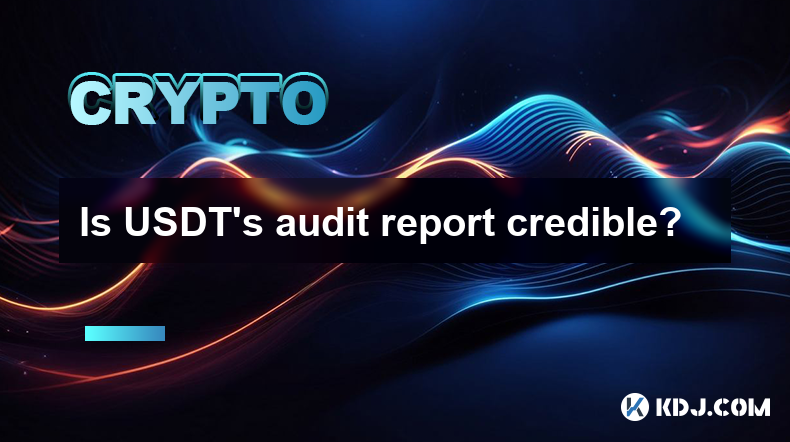
Is USDT's audit report credible?
Apr 02,2025 at 03:00pm
The credibility of USDT's audit report is a topic of significant interest and debate within the cryptocurrency community. USDT, or Tether, is a stablecoin that claims to be backed 1:1 by traditional fiat currencies, primarily the US dollar. The company behind USDT, Tether Limited, periodically releases audit reports to assure users of its solvency and t...

Is USDT's reserve transparent?
Apr 03,2025 at 01:50pm
USDT, also known as Tether, is a widely used stablecoin in the cryptocurrency market, designed to maintain a 1:1 peg with the US dollar. One of the most frequently asked questions about USDT is the transparency of its reserves. This article aims to delve into the details of USDT's reserve transparency, exploring the measures Tether Limited has taken to ...

What is the long-term stability of USDT?
Apr 04,2025 at 10:28pm
The long-term stability of USDT, also known as Tether, is a topic of significant interest within the cryptocurrency community. USDT is a type of stablecoin, designed to maintain a stable value by being pegged to a reserve asset, typically the US dollar. The stability of USDT is crucial for its widespread use in trading, as a hedge against volatility, an...

Is USDT's on-chain data public?
Apr 05,2025 at 08:49am
The transparency of USDT's on-chain data is a topic of significant interest within the cryptocurrency community. Tether, the company behind USDT, claims that its operations are transparent and that the on-chain data is publicly accessible. However, understanding the nuances of this data and how to access it can be challenging. This article will delve in...

How is the stability of USDT guaranteed?
Apr 03,2025 at 06:00am
The stability of USDT, also known as Tether, is a critical aspect that underpins its role as a stablecoin in the cryptocurrency market. USDT is designed to maintain a 1:1 peg with the US dollar, which is achieved through a combination of mechanisms and practices. Understanding these elements is essential for anyone interested in the stability and reliab...

How is USDT compliant?
Apr 05,2025 at 11:28am
USDT, also known as Tether, is a stablecoin that aims to maintain a stable value by being pegged to the US dollar. Ensuring compliance is crucial for Tether to maintain its reputation and operational integrity within the cryptocurrency ecosystem. Compliance in the context of USDT involves adhering to various regulatory standards, including anti-money la...

Is USDT's audit report credible?
Apr 02,2025 at 03:00pm
The credibility of USDT's audit report is a topic of significant interest and debate within the cryptocurrency community. USDT, or Tether, is a stablecoin that claims to be backed 1:1 by traditional fiat currencies, primarily the US dollar. The company behind USDT, Tether Limited, periodically releases audit reports to assure users of its solvency and t...

Is USDT's reserve transparent?
Apr 03,2025 at 01:50pm
USDT, also known as Tether, is a widely used stablecoin in the cryptocurrency market, designed to maintain a 1:1 peg with the US dollar. One of the most frequently asked questions about USDT is the transparency of its reserves. This article aims to delve into the details of USDT's reserve transparency, exploring the measures Tether Limited has taken to ...
See all articles




















































































